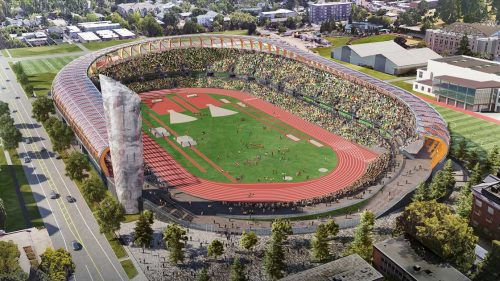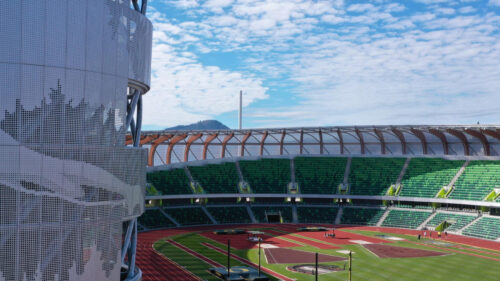Many of the world’s top athletes will flock to Eugene July 15-24, 2022 to participate in the World Athletics Championships Oregon22, being held in the United States for the first time in its 46-year history. Keeping with the tradition of customizing medals to highlight the host community’s sense of place, top finishers will take home medals that incorporate abstract representations of Oregon’s seven regions into their design.
As part of their efforts to create an Oregon keepsake for top finishers, Oregon22 organizers worked with Oregon companies, ensuring that the entire process — from inception to manufacture — took place right here in Oregon.
“It was imperative that our medals were true to the unique, unmissable, unconventional nature of the first World Athletics Championships on U.S. soil,” says Niels de Vos, executive director of Oregon22, LLC. “Months of cutting-edge creative thought and experimentation into the latest manufacturing techniques went into the medals, designed and fabricated right here in Oregon. The medals are won by athletes as the result of a lifetime of dedication and commitment. They are the best in the world, and our team wanted to ensure a medal which reflected that status.”
The medals are circular and designed to resemble the cross-section of a tree — a nod to the state’s timber industry. Each depicts seven growth rings to represent Oregon’s regions. The back of each medal features a relief of an iconic scene in Oregon. A nice feature is that winners will randomly receive a medal with one of seven different images of Oregon.
As the design team envisioned, the medals were created in Oregon. Portland fabricator Steelab was brought on to manufacture the entire package for winners: the medals, the lanyards and their corresponding keepsake boxes.


The medal fabricators weren’t the only aspect of the design inspired by and made by Oregonians. Eugene-based firm AHM Brands created a colorful tapestry that captures the event’s spirit for the track and field championship’s signage and promotional materials, as well as the winners’ medal sets.
The tapestry was inspired by natural elements in Oregon’s seven regions, using patterns and shapes to convey the state’s natural features. Silhouettes of buildings and landmarks help set each region apart. Here’s a sneak peek of the tapestry design, and how its abstract patterns correspond to some of Oregon’s most cherished places.
Oregon Coast
Stretching for 363 miles from the mouth of the Columbia River clear down to Oregon’s southern border, the Oregon Coast doesn’t fail to inspire. The design team found their own inspiration in the sea cliffs of Neahkahnie Mountain near Manzanita and the historic lighthouses of the Oregon Coast, which appear in bold triangular forms. Some you may even recognize the representation of Cannon Beach’s landmark Haystack Rock.
Willamette Valley
The Willamette Valley is honored with symbolic depictions of the region’s hilly wine country and the woods and waterfalls of the Willamette National Forest, represented by green mounds and vertical pale-blue stripes. True-to-form depictions of the Oregon State Capitol building in Salem and the University of Oregon’s Hayward Field in Eugene — quite familiar to track and field fans — also make an appearance.
Portland Region
The design team represents Portland with imagery inspired by some of the city’s most recognizable landmarks, including the White Stag sign and the steel tied-arch Fremont Bridge. Look carefully and you’ll spot a rendition of the city’s skyline, complete with a tiny version of the 35-story KOIN Tower.
Mt. Hood and Columbia River Gorge
The forests, mountains and waterways of Oregon’s Mt. Hood and Columbia River Gorge region stand out as graphic highlights of the region’s scenery. Light-blue lines represent Multnomah Falls, while a massive striped triangle in hues of navy and periwinkle suggests Mt. Hood’s iconic peak.
Southern Oregon
Southern Oregon appears as triangular forests and mountains, as well as striped mound-like forms designed to symbolize vineyards. There’s also a more recognizable image of the region’s best-known destination, Crater Lake National Park.
Central Oregon
Central Oregon’s high-desert landscapes appear in warmer shades of reds and yellows, and pyramid-shaped representations of the region’s towering Cascade Range. The designers also include a craggy depiction of the volcanic peaks of Smith Rock State Park, one of the most recognizable natural features in the region.
Eastern Oregon
The quiet, seemingly endless landscapes of Oregon’s least-populated region, Eastern Oregon, are depicted with triangular tree and mountain imagery, suggestive of the Malheur National Forest, Steens Mountain and the Wallowa Mountains. The hues of the ancient Painted Hills are evoked using a stripe pattern that progresses from shades of chartreuse to amber.



